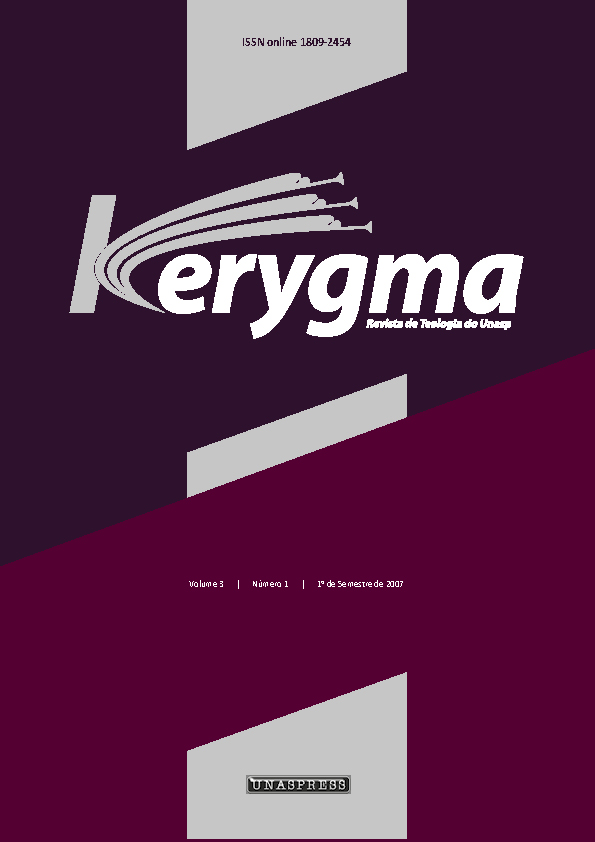Resumo
A presente investigação teve por objetivo considerar, de forma sintética, a questão da marcação de datas para o fim do mundo na era cristã, provocado pelo Segundo Advento de Cristo ou por alguma catástrofe de dimensões globais. Ênfase especial foi dada tanto ao processo euforia/desapontamento/letargia gerado pela marcação de datas quanto às implicações desse processo sobre o cumprimento da missão evangélica. O estudo da marcação de datas no decorrer da história do cristianismo baseou-se em fontes primárias e secundárias que tratam do assunto, cujas informações básicas foram apresentadas em uma seqüência cronológica. Marcações de tempo para o fim do mundo têm surgido ao longo da história do cristianismo. Diversos movimentos com esta tendência têm aflorado com base em uma hermenêutica bíblica equivocada (cf Mt 24:36; At 1:7). Datas têm sido marcadas em diferentes contextos históricos, sendo que algumas delas prevêem o fim do mundo quando o autor da predição ainda se encontra vivo. Alguns desses marcadores de tempo enfrentaram o opróbrio e a vergonha do não cumprimento do fato anunciado. Outros têm projetado as suas datas para um futuro distante deixando alguma possibilidade de desapontamento àqueles que venham a aceitar tais predições pouco tempo antes do suposto cumprimento. A pregação do evangelho tem sido afetada negativamente em virtude dessa atitude. Geralmente ocorre um reavivamento religioso antes da data sugerida para o fim do mundo. Contudo, em muitos casos, o não cumprimento da predição gera mornidão, quando o entusiasmo inicial é substituído por indiferença e frieza espirituais. Embora o problema possa ter ocorrido dentro de um ramo específico de uma denominação cristã, a denominação como um todo sofre com as críticas que se propagam de forma generalizada. Dessa forma, a pregação do evangelho tem de enfrentar uma nova onda de suspeita e descrença devido ao não cumprimento da predição supostamente baseada nas Escrituras.
Autores que publicam na Kerygma devem concordar com os seguintes termos:
- Uma vez aceitos para a publicação, os direitos autorais dos artigos são automaticamente transferidos à Kerygma.
- Todo material utilizado no texto que possua direitos autorais de terceiros devem estar devidamente referenciados.
- Os autores também devem deter os direitos de reprodução das imagens e tabelas em seu material, caso seja necessário.
- Os autores garantem que o texto submetido é de sua inteira autoria e não foi submetido e/ou publicado em nenhum outro local.
- As opiniões, ideias e conceitos emitidos nos textos são de inteira responsabilidade de seus autores e não representam, necessariamente, a opinião da Kerygma;
- É reservado aos editores o direito de proceder a ajustes textuais e de adequação às normas da publicação.
- Autores mantém os direitos autorais e concedem à revista o direito de primeira publicação, com o trabalho simultaneamente licenciado sob a Creative Commons Atribuição-NãoComercial 4.0 Internacional, que permite o compartilhamento do trabalho com reconhecimento da autoria e publicação inicial nesta revista. Essa licença permite que outros remixem, adaptem e criem a partir do seu trabalhopara fins não comerciais, e embora os novos trabalhos tenham de lhe atribuir o devido crédito e não possam ser usados para fins comerciais, os usuários não têm de licenciar esses trabalhos derivados sob os mesmos termos.
- Os autores concordam com a reprodução livre de seu material pela Kerygma, que poderá adaptar, modificar, condensar, resumir, reduzir, compilar, ampliar, alterar, mixar com outros conteúdos, incluir imagens, gráficos, objetos digitais, infográficos e hyperlinks, ilustrar, diagramar, fracionar, atualizar, traduzir e realizar quaisquer outras transformações, sendo necessária a participação ou autorização expressa dos autores.
- Os autores concordam que a Kerygma pode distribuir os artigos mediante cabo, fibra ótica, satélite, ondas ou qualquer outro sistema que permite acesso ao usuário em tempo e lugar determinados, seja por vias gratuitas ou por sistemas que importem pagamento. A Kerygma poderá ainda incluir o trabalho em banco de dados, físico ou virtual, arquivar em formato impresso, armazenar em computador, em sistema de nuvem, microfilmar e demais formas de arquivamento atuais ou que ainda possam ser desenvolvidas, com ou sem fins lucrativos.
- Autores têm autorização para assumir contratos adicionais separadamente, para distribuição não-exclusiva da versão do trabalho publicada nesta revista (ex.: publicar em repositório institucional ou como capítulo de livro), com reconhecimento na nova publicação que o artigo foi publicado originalmente nesta revista.
- A Kerygma é detentora dos direitos de todos os trabalhos publicados por ela. A reprodução integral desses textos em outras publicações, para qualquer outra finalidade, por quaisquer meios, requer autorização por escrito do editor. O mesmo serve para reproduções parciais, como resumo, abstract, porções com mais de 500 palavras do texto, tabelas, figuras, ilustrações etc.
- Autores têm permissão e são estimulados a publicar e distribuir seu trabalho online (ex.: em repositórios institucionais ou na sua página pessoal) a qualquer ponto antes ou durante o processo editorial, já que isso pode gerar alterações produtivas, bem como aumentar o impacto e a citação do trabalho publicado (veja “The effect of open access and downloads ('hits') on citation impact: a bibliography of studies”).

